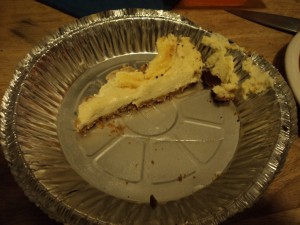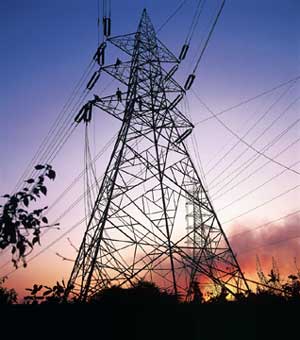I can’t believe she ate the whole thing…
December 25th, 2010
As if a cell phone, green leather loveseat, camera USB cord, air filter A/C cord, shoes, boxes of pens, funky-patterned couch, utility knife holder (!), chair cushion, roll after roll of toilet paper, highlighter all over off-white throw, rug, another rug, doggy bed, comforter, several dozen socks, oh, and did I mention TWO couches???, as if that isn’t enough, oh, our dear little puppy really did it this time…
Alan’s working on the pantry, I’m hoping to get the washer off the deck soon, assuming we can find it out there in all the snow… and after sawing off a 2×4, went into the kitchen. Ginger cheezecake was sitting out, THREE ginger cheezecakes were sitting out, and he didn’t put up the babygate, and Little Miss Counter Surfer ran in, from the kitchen all the way back in the office I heard the distinct sound of cheezecake going down, yelled “NO!” and ran in, it had hit the deck, cracked in a few pieces, Sadie headed under the dining room table, and Alan picked up what was left… as I put the gate up, she stood there, neck stretched out and snout against the edge, licking her lips… MORE PLEASE!!! Dear Little Sadie… MORE? You want MORE??? YOU ATE 90% OF IT!
AAAAAAAAGH!
And she picked the too brown one that I was saving for US! Oh, the little bitch… I am SO mad…
Annual Hearing – Power Plant Siting Act
December 23rd, 2010
Mark 10:00 a.m. on December 28, 2010 on your calendar!
Notice – Additional Information – 2010 Annual Power Plant Annual Siting Act Hearing
10:00 a.m. Tuesday, December 28, 2010
PUC Large Hearing Room – 3rd Floor
121 – 7th Place E.
St. Paul, MN 55101
It happens once a year, the Annual Power Plant Siting Act Hearing, which is our opportunity to tell them a thing or two, specifically what works and does not work about the Power Plant Siting Act. If you’re affected by CapX 2020 transmission or other utility infrastructure, you sure know what DOESN’T work!!! This is the time to let them know in technicolor, and to put together your legislative agenda for the coming session.
What’s new here is that they’re holding it before Eric Lipman, Administrative Law Judge, and are soliciting comments on specific questions:
l. In Chapter 216E, the Legislature directs the Commission to locate large electric power
facilities so that any siting is orderly, efficient and compatible with environmental
preservation. How well do the Commission’s procedures and practices meet these
mandates?2. How well do the regulations found in Minnesota Rules Part 7850 meet the mandates of
Chapter 2l6E? Which rules, if any, should the Commission consider revising?
3. How well do the regulations found in Minnesota Rules Part 1405 meet the mandates of
Chapter 216E? Which rules, if any, should the Commission consider revising?
Comments are invited through presentation of oral or written statements.
Written statements may also be submitted to Judge Lipman by the close of business on February 1,2011 . I’ll post the email address they’re using for this after the hearing or if I get it sooner.
We’ve been doing this for a while, here are the notes and reports to EQB/PUC — where there are no “Summary” notes, there were none online. I’ve also noticed that the exhibits that the Reports say are attached are not, and yet if I go back to the docket, they are attached there (see 2007, taken from PUC eDockets, not Commerce site, which is missing the exhibits). To look at the full PUC eDocket for a particular year, look below for docket numbers, and then go to www.puc.state.mn.us and click “Search eDockets” and plug in the docket number.
2006 Report to PUC – Docket 06-1733
2007 Report to PUC – Docket 07-1579
2008 Report to PUC – Docket 08-1426
2009 Report to PUC – Docket 09-1351
Here’s the law that’s the basis for it:
216E.07 ANNUAL HEARING.
The commission shall hold an annual public hearing at a time and place prescribed by rule in order to afford interested persons an opportunity to be heard regarding any matters relating to the siting of large electric generating power plants and routing of high-voltage transmission lines. At the meeting, the commission shall advise the public of the permits issued by the commission in the past year. The commission shall provide at least ten days but no more than 45 days’ notice of the annual meeting by mailing or serving electronically, as provided in section 216.17, a notice to those persons who have requested notice and by publication in the EQB Monitor and the commission’s weekly calendar.
History: 1973 c 591 s 8; 1975 c 271 s 6; 1977 c 439 s 11; 1980 c 615 s 60; 1982 c 424 s 130; 1984 c 640 s 32; 2001 c 212 art 7 s 17; 2005 c 97 art 3 s 9; 2007 c 10 s 12
Time to subpoena Mike Bull!!!
December 21st, 2010
Let me see if I understand this… we’ve got Ingrid Bjorklund, a wind industry lobbyist/employee now Commerce employee and Deb Pile, also Commerce, using Affidavits to argue LEGISLATIVE intent based on statements by Mike Bull, Commerce employee working under Pawlenty’s roof now working for Xcel. EH? LEGISLATIVE intent based on industry lobbyist/employee & Exec agency employee hearsay affidavits of Pawlenty’s Energy Boy. Where’s the LEGISLATURE in legislative intent? And what does Mike Bull have to say about this?
Duck and cover, Mikey! Commerce has trained their sights on you!
HUH? What’s going on? Well, we just had a deadline for submittals in response to the First Prehearing Order in the AWA Goodhue Wind contested case regarding application of Goodhue County’s Wind Ordinance. for the whole docket, go to www.puc.state.mn.us and click on “Search eDockets” and search for docket 08-1233.
Here’s the prelude to yesterday’s filings:
Staff Chart of Differences between Goodhue Ordinance & State Standards prepared for PUC Chair Boyd
After a Prehearing Conference and the ALJ’s request for our positions in this case, we submitted memos and then the ALJ issued a Prehearing Order:
In that order we were asked to set out the differences between county and state standards; whether county ordinance is a conflict, supplement, or something new; whether it should be applicable to this project; material facts regarding this issue; and what evidence we’d introduce. and here’s what was filed — where’s everybody else? Anyway, read the Deb Pile and Ingrid Bjorklund Affidavits and note who’s sayin’ what, whose interests are at issue, whose intent is couched as “LEGISLATIVE” intent, and while you’re at it, ask just what role they had at that time. Seems to me they’re putting it all on Mikey Bull. Hey Mikey?!?! Get ready!
Goodhue Wind Truth 2nd Prehearing Memo
Belle Creek Township 2nd Prehearing Memo
MOES Comments – PUC Briefing Papers on Goodhue
PATH transmission challenged by WVa PSC staff
December 18th, 2010
Click map for larger version:
PATH, the Potomac Appalachian Transmission Highline, is in trouble… AGAIN…
The good news is that the West Virginia Public Service Commission staff is challenging need for the PATH line, which was already postponed by PJM. And then there’s these pesky states questioning the need, like Maryland, which challenged the corporate organizational form, noting that it wasn’t a utility so “get outta here!”
Now it’s time for the West Virginia PSC staff to raise its eyebrows and deliver a solid Motion to Dismiss:
For the entire docket, go here:
And here’s the way it looks in the press:
$2B PATH project faces dismissal by W. Va. regulators
Private company can’t condemn for transmission line
December 14th, 2010
It’s about time… a judge in Montana has declared that a private entity that is building the MATL transmission line does NOT have the power of eminent domain! Well DUH a lot of us will say, this is a PRIVATE company, they’re not a regulated utility, so of course they wouldn’t have power of eminent domain.
But wait… what about CapX 2020, and their transmission plans from hell across the Midwest. Let’s be clear — there is NO entity organized under the laws of the state of Minnesota named “CapX 2020,” and they have NOT declared, and refuse to declare what entity will own it. At the same time, the Minnesota PUC agenda lately has had Xcel transferring its transmission assets to ITC. So, what do you think they’ll do with CapX 2020 transmission after it is built USING THE POWER OF EMINENT DOMAIN TO DO IT? $50 says they’re transferring it to ITC, or TRANSLink or whatever transmission only company they can find. It’s a shell game, we know what they’re doing, but try to get the PUC to care!
Judge denies MATL use of eminent domain
By KARL PUCKETT • Tribune Staff Writer•
December 14, 2010A district judge in Montana ruled Monday that a Canadian developer of a high-voltage power line has no authority to condemn private property for the project.
The decision, filed Monday, is a victory for landowners trying to limit the impact of the Montana Alberta Tie Line. It also could carry ramifications for other developers proposing transmission projects to meet demand from wind developers asking for additional shipping capacity.
“Larry Salois only wanted to protect his mother’s property from the transmission line going through historic Indian archaeological sites,” said Salois’ attorney, Hertha Lund. “He never wanted a legal battle.”
Salois is the guardian of his mother, Shirley Salois, the property owner. They live east of Cut Bank.
In July, a Montana subsidiary of Tonbridge Power Inc. of Toronto filed a complaint to condemn their land in Glacier County District Court after Salois argued the proposed route should be adjusted across his property farther from tepee rings and a wetland.
Lund argued Tonbridge could not exercise the right of eminent domain because it is not an agent of the state that has been given express legislative authority to acquire private property.
District Judge Laurie McKinnon agreed and granted Salois’ motion to dismiss the company’s condemnation complaint.
“No judicial decision that this court is aware of provides authority for MATL’s position that a private merchant transmission line, without express or implied authority for condemnation, may pursue eminent domain proceedings,” she wrote.
The Legislature’s grant of eminent domain power to governmental bodies must be strictly construed, the judge said.
Private individuals and corporations, like state agencies, have no inherent power of eminent domain, McKinnon said, and their authority to use it must be derived specifically from the Legislature.
Years ago, condemnation by a public utility for the purpose of constructing electrical power lines was authorized by legislation, the judge said. That authority allowed the former Montana Power Co. to acquire property by eminent domain.
But that legislation has since been repealed “and MATL can cite no legislative authority for its pursuit of land acquisitions by eminent domain, either expressly or by necessary implication,” the judge said.
Tonbridge had asserted that an electrical transmission line is a public use, giving the company the right of eminent domain. Three wind farm developers have purchased capacity on the line. Poles started going in the ground in August with the company working around the Salois property.
Bob Williams of Tonbridge said the company was surprised and disappointed with the decision. Tonbridge is considering an appeal, he said.
Voluntary deals with landowners remain the company’s goal, he said. The Salois complaint was the company’s first condemnation action in Montana.
“That said, projects such as this that are in the public interest have to be able to fall back on eminent domain as a last resort,” Williams said.
“Even when we have exhausted all other options, it still means that landowners are compensated fairly.”
The MATL project was permitted under the Major Facilities Siting Act and the public need for it was determined during the review process, said Johan van’t Hof, Tonbridge’s CEO.
He argued the judge’s decision “doesn’t square with the reality” of private companies building cable, telephone, transmission and pipelines.
As a result of the decision, Lund, Salois’ attorney, expects other businesses planning transmission lines to seek a “legislative fix,” giving companies the power to condemn land for transmission lines.
NorthWestern Energy, the state’s largest utility, is planning the $1 billion Mountain States Transmission Intertie, which also would ship wind power. Tonbridge and renewable energy developer Gaelectric are jointly planning the “Green Line” between Great Falls and Townsend.
“I hope the Legislature protects the interest of the landowner and the small guy in this process,” Lund said.
The 215-mile transmission line will connect the electricity grids in Montana and Alberta between Great Falls and Lethbridge, Alberta.
Tonbridge still is negotiating easements with landowners along the southern half of the project from Cut Bank to Great Falls, where construction has yet to begin. Lund also represents 20 landowners along that stretch in easement negotiations. Those landowners have been pushing for tweaks in the line as well.
“This obviously puts them in the driver’s seat,” Lund said of the Salois decision.
Salois pushed the company to alter the location of poles planned for his property, outside of the 500-foot approved corridor, because he said the line was planned too close to Blackfeet tepee rings and a wetland.
In October, the Blackfeet Business Council agreed to write a letter in support of Salois’ efforts. The council said the land involved was once Blackfeet land and told Salois that he had the support of the nine-member council “in your efforts to fend off this incursion by a multinational company.”
“For now, things are protected,” Larry Salois said.
Tonbridge initiated settlement discussions with Salois a few weeks ago and hopes to reach an agreement before Christmas, van’t Hof said.





